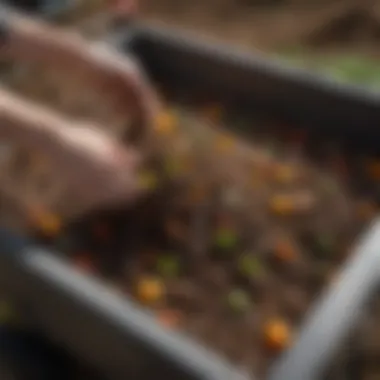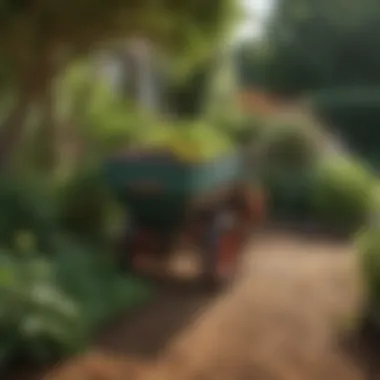Understanding Compost Carts: Your Guide to Sustainable Gardening


Intro
Composting has become a crucial practice for individuals and communities seeking to reduce waste and improve soil health. Central to this process are compost carts, which offer practical solutions for managing organic waste efficiently. These carts not only facilitate composting but also align with sustainable gardening practices that emphasize environmental stewardship.
Understanding compost carts encompasses their structure, functionality, and the variety of types available. From simple designs suitable for home gardens to more elaborate systems for larger scale composting, the options can be overwhelming. Here, we will discuss the relevance of compost carts, breaking down their advantages and providing best practices to maximize their utility.
Key Points to Consider
- Types of Compost Carts: Different models cater to various needs.
- Construction and Design: Materials and design elements affect performance.
- Advantages of Using Compost Carts: Improve waste management and soil health.
- Best Practices: Techniques to optimize composting processes.
Exploring the world of compost carts allows gardeners and culinary enthusiasts to make informed choices that not only enrich their gardens but also contribute to a healthier planet. By the end of this guide, readers will have a comprehensive understanding to implement effective composting practices.
The Concept of Composting
Understanding composting is essential for anyone interested in sustainable gardening and waste management. Composting transforms organic material into nutrient-rich compost, which can vastly improve soil health. This process not only supports gardening endeavors but also contributes to environmental conservation by reducing landfill waste.
Definition of Composting
Composting is the natural process of recycling organic matter, such as leaves, food scraps, and yard waste, into a valuable fertilizer. This process involves microorganisms breaking down the material in a controlled environment. By maintaining the right balance of carbon, nitrogen, moisture, and oxygen, composting can occur effectively. The final product is a dark, crumbly substance known as compost, which serves as an amendment to soil, introducing vital nutrients.
Environmental Benefits
The environmental benefits of composting are significant. Firstly, it minimizes the amount of waste sent to landfills, which are a major source of greenhouse gases when organic matter decomposes anaerobically. Moreover, composting enriches soil, which helps in retaining moisture and reduces the need for chemical fertilizers. This practice not only supports healthy plant growth but also enhances biodiversity in the soil ecosystem.
Key environmental benefits include:
- Reducing landfill waste
- Lowering greenhouse gas emissions
- Enhancing soil quality
- Promoting sustainable agricultural practices
"Composting is not just a method of recycling; it is an essential tool in the fight against climate change."
Soil Enrichment
Soil enrichment is another critical aspect of composting. When compost is added to soil, it improves its structure, fertility, and overall health. Compost consists of essential nutrients such as nitrogen, phosphorus, and potassium, which are beneficial for plant growth. Additionally, compost improves soil aeration and drainage while enhancing the water retention capacity. This is particularly beneficial during dry seasons, as plants will have access to moisture.
In summary, understanding the concept of composting is foundational for anyone engaged in gardening or environmental sustainability. The positive impacts on both the soil and the environment underscore the importance of composting in modern waste management and cultivation practices.
Understanding Compost Carts
Compost carts play a crucial role in the realm of sustainable gardening and waste management. They offer an organized, efficient way to collect and manage organic waste, central to composting practices. The importance of compost carts cannot be understated for eco-conscious individuals seeking to reduce waste and enrich their gardens. This section discusses various characteristics, benefits, and considerations that surround compost carts, which are fundamental to understanding how they enhance environmental health and soil quality.
What is a Compost Cart?
A compost cart is a designated container used for gathering organic materials that will eventually decompose into compost. These carts come in various designs, usually constructed with durable materials like plastic, metal, or wood. They often include features such as a lid for odor control, wheels for easy movement, and ventilation holes to promote airflow, which aids in the composting process.
The primary function of a compost cart is to ease the collection of kitchen scraps, yard clippings, and other biodegradable materials. They are especially useful for those who wish to compost but do not have space for a traditional compost pile.
"Compost carts help streamline the composting process, making it accessible to everyone, regardless of space constraints."
History of Compost Carts
The concept of composting has existed for centuries, but the evolution of compost carts is more recent. Initially, composting was done in heaps, where materials were simply piled up in a designated area. This approach required significant effort and oversight, often leading to inefficiencies in managing the process.
With an increasing awareness of environmental issues in the late 20th century, the need for better composting solutions became apparent. The introduction of compost carts provided a focused approach, making it easier for individuals to participate in organic waste management. Over time, the designs of compost carts improved, incorporating features that maximized efficiency and ease of use. Today, these carts reflect a greater understanding of composting processes and the need for environmental sustainability.
In summary, understanding compost carts provides insight into their vital role in composting practices and how they contribute to sustainable gardening. By facilitating the collection and management of organic materials, they significantly influence individual and communal efforts towards a healthier environment.
Types of Compost Carts


Understanding the various types of compost carts is vital for gardeners and eco-conscious individuals aiming to enhance their composting efforts. Each type has unique characteristics, advantages, and materials that cater to different needs and preferences. Choosing the right cart can profoundly affect the composting process, contributing to better waste management and soil enrichment.
Plastic Compost Carts
Plastic compost carts are popular for their lightweight and durable nature. They offer resistance to weather conditions, which makes them suitable for outdoor use. Many of these carts feature a tightly sealed lid, keeping pests away and retaining moisture, which is crucial for decomposition.
- Benefits:
- Lightweight and portable – Easy to move around in your garden
- Durable – Resistant to rust and corrosion
- Cost-effective – Typically less expensive than metal options
Despite these advantages, plastic may fade over time due to sun exposure. Users should consider investing in a cart with UV-resistant materials for longevity. Ventilation holes are often included in the design to allow airflow, promoting aeration within the compost pile.
Metal Compost Carts
Metal compost carts are renowned for their sturdiness and longevity. They are often made from stainless steel or galvanized metal, providing durability that is advantageous for long-term usage. These materials can withstand rigorous weather conditions without deteriorating.
- Advantages:
- Durability – Less likely to be damaged by elements or pests
- Eco-friendly – Metal is recyclable, promoting sustainability
- Good aeration – Many designs feature perforations to improve airflow
However, metal carts can be heavier, making mobility more challenging. Routine maintenance is also important to prevent rusting. Overall, they are a solid investment for those looking for a robust compost solution.
Wooden Compost Carts
Wooden compost carts are often aesthetically pleasing and can blend into garden landscapes seamlessly. They are usually constructed from untreated wood, which allows for natural biodegradation over time. The use of wood is also advantageous as it is a renewable resource.
- Key Features:
- Natural look – Enhances garden beauty
- Breathability – Wood can naturally circulate air, aiding decomposition
- Customization – Easily modified or built to specific dimensions
On the downside, wooden carts require more maintenance compared to plastic and metal options. They are prone to decay if not treated with care. Users should be prepared for occasional sealing or treatment to prolong their life.
With a clear understanding of these types, one can make informed decisions that align with their composting goals and environmental consciousness.
Design Features of Compost Carts
In examining compost carts, the design features play a crucial role in their overall efficiency and effectiveness. A well-designed compost cart can streamline the composting process, making it easier for users to recycle organic waste. By considering the design elements, such as size, ventilation, aeration, mobility, and stability, users can enhance their composting experience.
Size Considerations
When selecting a compost cart, size is one of the first features to consider. The ideal size will depend on the volume of organic waste generated in a household or garden. A larger compost cart can accommodate more materials, which is beneficial for households that produce significant organic waste. However, this can also lead to complications such as difficulty in turning the compost or accessing materials at the bottom.
On the other hand, smaller carts are easier to manage and maintain but require more frequent emptying and may not keep up with higher volumes of waste. Users should evaluate their composting needs and available space to find a cart size that fits their lifestyle.
Ventilation and Aeration
Effective composting hinges on proper ventilation and aeration. Compost carts must allow for adequate air flow to promote the decomposition process. Good ventilation helps to balance moisture levels and reduces odors. Carts designed with holes or vents allow air to circulate, supporting aerobic decomposition, which is more efficient and produces fewer odors compared to anaerobic processes.
Aeration can also be achieved by incorporating features that allow for easy turning of the compost. Some carts include internal mechanisms or stirring rods that help mix materials, ensuring even decomposition and consistent aeration. Making sure the cart facilitates proper ventilation will lead to healthier compost.
Mobility and Stability
Mobility is crucial for users who need to move their compost cart around the yard or garden. A well-designed cart should be easy to maneuver, regardless of the amount of compost inside. Features such as sturdy wheels can make transportation smoother, while a lightweight design enables users to move the cart without excessive strain.
Stability is another essential factor. A cart needs to maintain balance, especially when loaded with organic materials. A bottom with a broad base can help in achieving stability. Additionally, a cart that doesn’t tip over can prevent spills and aid in safe composting practices.
"A compost cart that combines mobility and stability will greatly enhance a user's experience and encourage them to engage more with sustainable practices."
Advantages of Using Compost Carts


Compost carts offer several benefits, making them an essential tool for effective composting. Understanding the advantages helps users appreciate their value in sustainable practices. They simplify the process and maximize results.
Ease of Use
One key advantage of compost carts is their ease of use. Unlike traditional composting methods that may require physical strain, compost carts provide a user-friendly solution. They often come with wheels, allowing effortless movement from one location to another. Users can collect kitchen scraps and yard waste efficiently and deposit them into the cart.
Additionally, many compost carts have features like lids or covers. This helps keep pests out and manage odors. Everyday users find that the user-friendly design minimizes the effort required to start composting. Therefore, people can focus on enriching their gardens without feeling overwhelmed.
Improved Composting Efficiency
When it comes to composting efficiency, compost carts are hard to beat. The design encourages proper aeration, which is key to effective decomposition of organic material. The ability to turn and mix compost easily contributes to rapid breakdown of waste. Regular turning ensures that all parts of the compost are exposed to oxygen. This is essential for aerobic bacteria to thrive and facilitate decomposition.
Studies indicate that using a compost cart can reduce the time it takes for organic matter to turn into compost by up to 50%. This is a significant gain for anyone wanting to enhance soil quality in a shorter timeframe. In addition, some compost carts are designed with features like perforated sides to improve airflow even further.
Space Saving
Another notable benefit of compost carts is their space-saving design. Many units are compact and can fit into small areas, making them suitable for homes with limited outdoor space. The vertical design allows users to place them in corners or tight spots without hassle.
Moreover, compost carts can be a great solution for urban gardening. They help reduce the need for large compost piles, which can take up considerable space. By effectively consolidating organic waste in a single container, users can manage their composting efforts without sacrificing yard area.
Compost carts show their worth not just in efficiency but also in the practical aspects of managing space. In increasingly urban environments, these benefits stand out as essential considerations for the eco-conscious gardener.
Best Practices for Using Compost Carts
Using compost carts efficiently involves following certain best practices. Adopting these practices not only ensures effective composting but also enhances the benefits derived from the process. By focusing on correct material selection, moisture management, and aeration techniques, users can optimize their composting efforts.
Selecting the Right Materials
Choosing the appropriate materials is fundamental to successful composting. Materials can be categorized into greens and browns. Greens include nitrogen-rich items like vegetable scraps and grass clippings. Browns refer to carbon-rich materials such as dry leaves, straw, and paper. A balanced mix of these materials is crucial for fostering microbial activity, which, in turn, breaks down the organic matter effectively.
It is vital to avoid certain items that can disrupt the composting process. For example, meats, dairy products, and oily foods may attract pests. Additionally, synthetic materials or treated woods should not be included, as they can introduce harmful chemicals into the compost.
Proper material selection enhances the composting process while minimizing negative impacts on your garden.
Maintaining Proper Moisture Levels
Moisture plays a critical role in composting. Ideally, the compost should have a damp, sponge-like quality. Excess moisture can lead to anaerobic conditions, creating foul odors and slowing decomposition. Conversely, too little moisture can hinder microbial activity and result in a dry, ineffective pile.
Regularly checking moisture levels assists in preserving compost quality. If the compost appears dry, water it lightly to achieve the desired consistency. Conversely, if it is too wet, turning the pile can help aerate the material, thereby allowing excess moisture to escape.
Regular Turning and Aeration
Aeration is another essential practice in using compost carts. Regularly turning the compost pile introduces oxygen, promoting aerobic decomposition. Without adequate aeration, the compost may become compacted, leading to poor decomposition rates.
Turning the compost every few weeks ensures that materials break down uniformly. It also helps manage temperature, which can rise significantly during decomposition. A good rule is to turn the compost when temperatures exceed 140 degrees Fahrenheit. This practice not only enhances aerobic activity but also helps in pest control.
Challenges with Compost Carts
Navigating the world of compost carts involves understanding that, while they are useful tools for efficient waste management and soil enrichment, there are several challenges inherent in their use. Addressing these challenges is crucial for maximizing the benefits of composting. This section explores specific areas—space limitations, pest control, and managing odors—that can affect the effectiveness of compost carts.
Space Limitations
Space is often a significant concern for gardeners using compost carts. Not every household has a yard or garden that provides enough room for a large composter. In urban settings, where space is limited, compost carts can take up essential area that might otherwise be utilized for more traditional gardening activities. As a result, it's important to assess available space before committing to a specific cart.
Those with limited space may need to consider smaller composting systems or multi-functional designs that integrate composting into existing structures. For example, some carts are designed to fit into small corners or can be wall-mounted.
Pest Control


Pests are an ever-present risk when composting, especially if the cart is not maintained properly. Rodents, insects, and other unwanted visitors can be attracted to food scraps if they are not sealed securely. It is essential to choose compost carts that have proper sealing mechanisms. Additionally, purchasers should explore options equipped with features that deter rodents. This might include metal mesh screens or heavy-duty plastic that prevents easy access.
Regular monitoring and maintenance are also critical. By inspecting the compost regularly, users can identify any issues before they escalate, ensuring that pests do not become a larger problem.
"Regular maintenance is key to preventing pest issues in compost carts. Proper attention can save time and enhance compost quality."
Managing Odors
Odors can be another deterrent for those looking to compost. A well-maintained compost cart should produce minimal smell. However, factors such as improper material balance or inadequate aeration can lead to foul odors. To manage this, it is essential to follow best practices regarding what materials to include. Every compost cart should have a mix of nitrogen-rich and carbon-rich materials to support proper decomposition.
Additionally, ensuring proper aeration is vital. Users should regularly turn their compost to promote airflow and prevent anaerobic conditions, which often lead to odor problems. Keeping a lid on the cart can also help contain smells, but if odors persist, adjusting the mixture may help solve the issue.
Being proactive about these challenges can help users enhance their composting experience. By understanding space limitations, pest control strategies, and managing odors, gardeners can make the most of their compost carts while contributing positively to their gardening practices.
Cost Considerations for Compost Carts
When considering the value of compost carts in sustainable gardening, it is essential to evaluate the cost aspects. Many find that the initial investment into a compost cart can lead to significant advantages down the line. Not only does a well-chosen compost cart enhance one's composting efforts, but it can also contribute to financial savings over time. Understanding these costs can help informed decisions for anyone dedicated to ecological practices.
Initial Investment
The initial investment in a compost cart can vary greatly based on materials, size, and design. Plastic compost carts are often less expensive compared to metal ones. A basic plastic cart might cost around $50, while premium models can go over $200. Metal compost carts, while generally more durable, may start at about $100 and can reach upwards of $300 for high-quality variants.
Thus, when investing in a compost cart, it is important to balance cost against potential durability and longevity. Upfront costs may appear steep for some, but considering the materials and construction can justify a higher price tag, as it often results in a longer lifespan and reduced need for replacements. Additionally, larger compost carts may require more investment, but they also facilitate greater compost production, which can offset costs through enhanced gardening efficiency.
Long-Term Savings
Investing in a compost cart can translate into long-term savings in a few distinct ways. First, composting at home reduces waste that would otherwise go to landfills. Fewer waste disposal costs can accumulate over time, leading to significant savings.
Furthermore, a successful composting process yields high-quality compost. This rich soil amendment can reduce the need for store-bought fertilizers or soil enhancements. Calculating the reduction in these purchases can illustrate substantial savings throughout multiple growing seasons.
Lastly, a compost cart encourages better gardening outcomes. Increased plant health and productivity lead to higher harvest yields. This amplifies the return on investment over time, emphasizing that a compost cart is more than just a tool; it is an investment in both sustainability and personal economy.
Investing in a compost cart is not merely about initial expenditure but rather the overall value it provides to gardeners keen on sustainability.
Finale
The conclusion of this article serves as a focal point for understanding the critical role compost carts play in sustainable gardening practices. Effective composting requires not just the right materials but also the right tools. Compost carts emerge as indispensable allies in this endeavor, especially when considering their numerous benefits that extend beyond mere functionality.
In the forthcoming years, it is anticipated that the demand for compost carts will rise. As urbanization increases and more people focus on eco-friendly practices, these tools will gain prominence. The evolving designs and features of compost carts will make them more adaptable to varying gardening spaces. Thus, their contribution to effective waste management and soil enhancement is undeniable.
"Composting with the right equipment not only enriches your garden but also mitigates waste in landfills."
Efforts to encourage sustainable practices hinge on education and accessibility. By making composting easier through tools like compost carts, individuals are more likely to engage in eco-friendly practices. This not only improves soil health but strengthens community gardens and local ecosystems.
Ultimately, the overarching message is clear. Investing in a compost cart is not merely a purchase; it is a dedicated step towards sustainable living. Proper utilization of these carts will facilitate enriched soil, healthier plants, and, by extension, a healthier environment. It is a commitment that brings long-lasting benefits, reinforcing the indispensable connection between gardening, waste management, and sustainability.
The Future of Compost Carts
The future of compost carts appears promising as society increasingly values sustainable practices. With advancements in technology, compost carts are likely to become more efficient. For instance, innovations in materials that allow for better insulation and moisture retention can lead to more effective composting processes.
New designs might incorporate smart technology, enabling users to monitor the composting process through an app. Such developments can help in maintaining optimum conditions for composting, which can lead to higher quality end products. This convergence of technology and gardening could democratize composting, making it even more accessible to individuals with diverse backgrounds and gardening expertise.
With the right focus on these technologies, compost carts could play a central role in urban gardening and community farms. These carts can assist in reducing waste while improving nutrition in local soils.
Encouraging Sustainable Practices
Encouraging sustainable practices is essential for the health of our planet. As individuals incorporate composting into their routines, they contribute to broader environmental goals. Education about composting and the proper use of compost carts can cultivate a culture of sustainability, turning what was once a tedious task into a rewarding activity.
People can form community groups to share knowledge about composting and its benefits. Workshops that demonstrate how to use compost carts can empower more individuals to join this eco-friendly movement. The social aspect of gardening and composting can bolster community ties as well.
In addition, local governments can offer incentives for composting practices. This may include discounts on compost carts or educational programs for schools. Partnerships with local garden centers can further spread awareness:
- Hosting composting events
- Providing starter kits for new composters
- Creating informational resources that simplify the composting process
Overall, the future and the sustainability of gardening rely heavily on effective composting methods in which compost carts play a vital role. By understanding and implementing these practices, individuals and communities can foster an environment that values sustainability.















